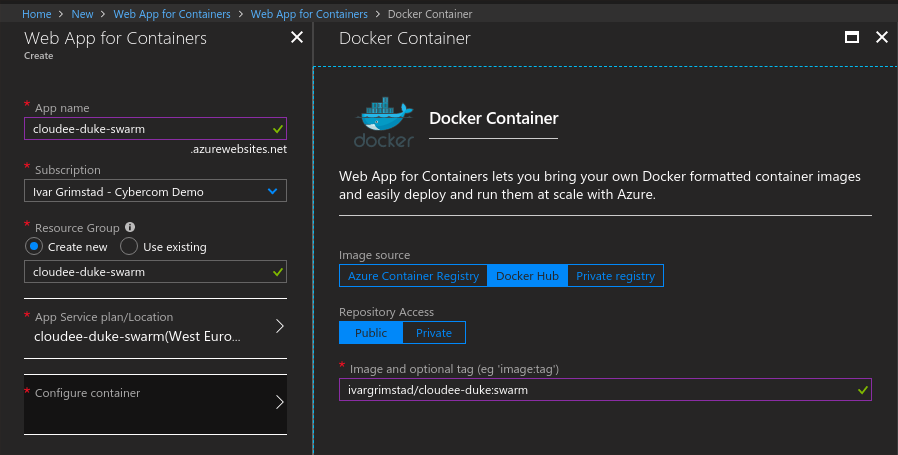In this post, I am following up on the post series about Running Eclipse MicroProfile applications in Oracle Cloud by showing how to do it in Microsoft Azure Web Apps for Containers.
I am using the same simple application called CloudEE Duke as in the previous posts. The only difference is that I now package the applications as Docker Images. In this example, I show how to use the fabric8 Maven Plugin to produce a docker image for WildFly Swarm.
<plugin>
<groupId>io.fabric8</groupId>
<artifactId>docker-maven-plugin</artifactId>
<version>${version.docker-maven-plugin}</version>
<configuration>
<images>
<image>
<alias>${project.artifactid}</alias>
<name>ivargrimstad/${project.artifactId}:swarm</name>
<build>
<maintainer>Ivar Grimstad (ivar.grimstad@gmail.com)</maintainer>
<from>jboss/base-jdk:8</from>
<assembly>
<basedir>/</basedir>
<inline>
<files>
<file>
<source>${project.build.directory}/${project.build.finalName}-hollow-swarm.jar</source>
<outputDirectory>/opt</outputDirectory>
</file>
<file>
<source>${project.build.directory}/${project.build.finalName}.war</source>
<outputDirectory>/opt</outputDirectory>
</file>
</files>
</inline>
</assembly>
<entryPoint>
<arg>java</arg>
<arg>-Djava.net.preferIPv4Stack=true</arg>
<arg>-jar</arg>
<arg>/opt/${project.build.finalName}-hollow-swarm.jar</arg>
<arg>/opt/${project.build.finalName}.war</arg>
</entryPoint>
</build>
</image>
</images>
</configuration>
<executions>
<execution>
<phase>package</phase>
<goals>
<goal>build</goal>
</goals>
</execution>
</executions>
</plugin>
The configuration is similar for the other Eclipse MicroProfile implementations. See the full pom.xml for examples. To produce the docker image for the WildFly Swarm implementation of CloudEE Duke, use the following command:
mvn clean package docker:build -Pswarm
Once the image is produced, you need to publish it to a container registry. In my case I simply push it to my public Docker Hub.
In order to deploy the CloudEE Duke application in Microsoft Azure, log in to your Azure Portal and create a new Web App for Containers as shown below.

Since WildFly Swarm runs on port 8080 by default (and I am using all defaults here), the port number for the application needs to be configured. This can be done either in the UI, or using Cloud Shell as shown here:

When your application is deployed, you should be able to access the hello endpoint.
https://cloudee-duke-swarm.azurewebsites.net/hello
Duke says Hello!
https://cloudee-duke-swarm.azurewebsites.net/health
{
outcome: “UP”,
checks: [ ]
}
https://cloudee-duke-swarm.azurewebsites.net/metrics
# HELP base:classloader_total_loaded_class_count Displays the total number of classes that have been loaded since the Java virtual machine has started execution.
# TYPE base:classloader_total_loaded_class_count counter
base:classloader_total_loaded_class_count 13697.0